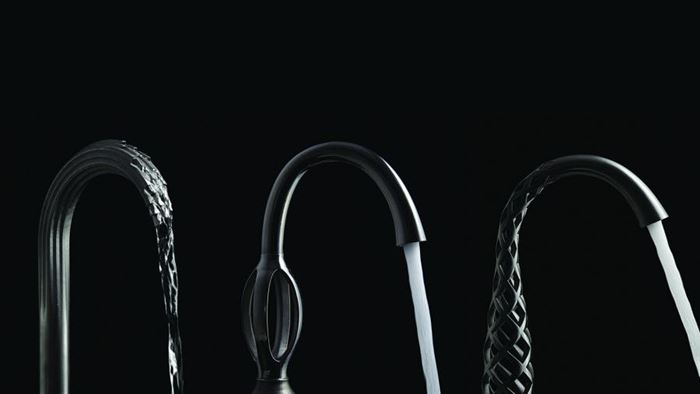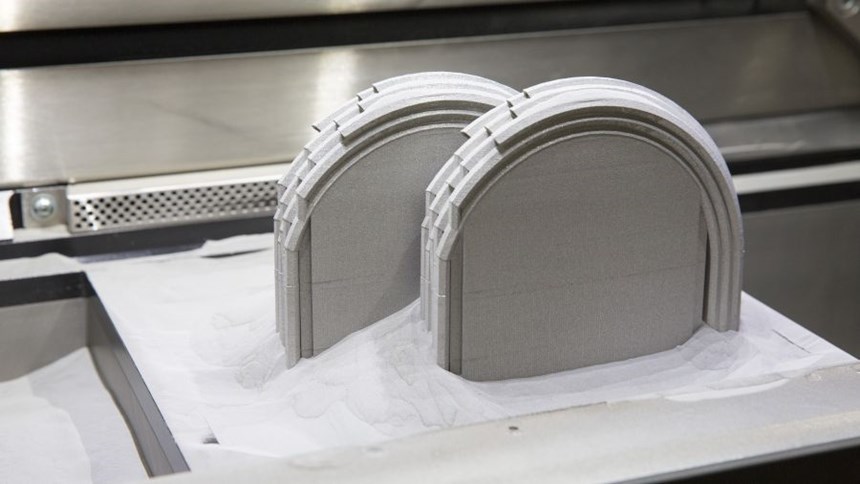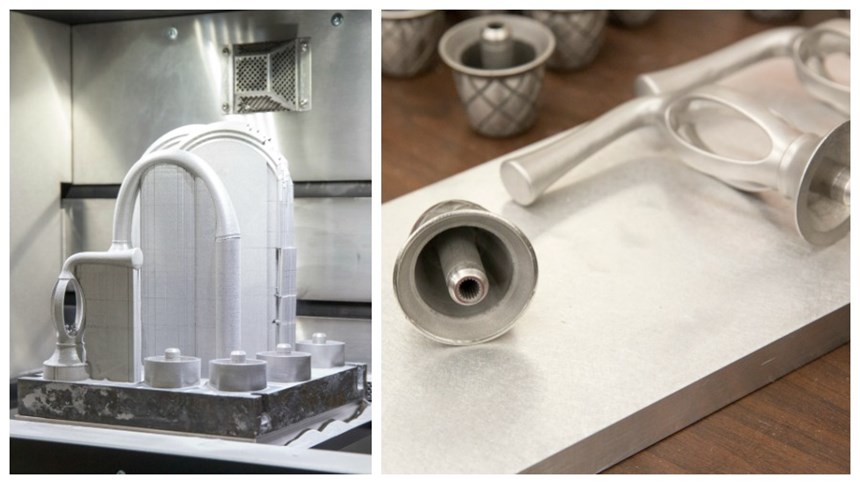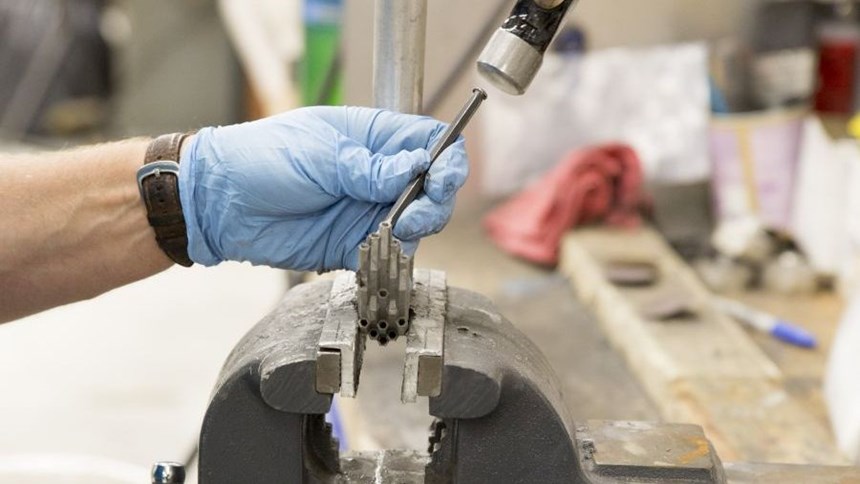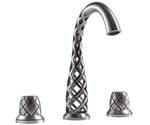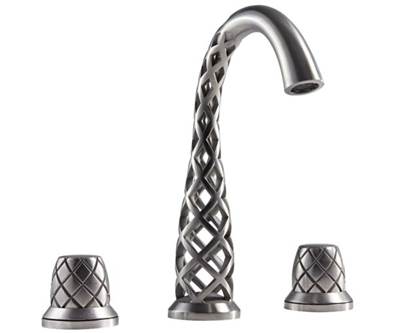Testing the Waters with DMLS Faucets
A plumbing products manufacturer is expanding its luxury line with a series of faucets that could only be produced with AM.
“We knew if we were going to use an additive manufacturing technique, we had to use it fully and we had to challenge ourselves to create something that could not be made any other way,” Jean-Jacques L’Henaff, vice president of design at DXV, the luxury brand of LIXIL Water Technology America, says of the plumbing manufacturer’s decision to pursue metal additive manufacturing for production. Rather than reproduce existing designs with AM technology, the company realized an opportunity to create innovative new ones.
DXV, which operates along with American Standard as part of the global LIXIL Water Technology Americas division, has developed a series of three Inconel faucets that are said to be the first functional residential faucets built via direct metal laser sintering (DMLS). The DMLS faucets’ award-winning designs channel the natural flow of water in a brook, or give the impression that water comes from nowhere. These designs could not have been made by casting or machining, and their creation demanded new ways of thinking about design, product development and the supply chain.
The Decision to Try
When DXV discontinues a product line, the company is left with obsolete inventory. It was this fact that first sparked the creation of the 3D-printed faucet line. The company saw that additive manufacturing could allow it to produce products on-demand, without the need to create and store inventory. It also recognized that the advancement of additive manufacturing techniques for metals made production a real possibility.
“We realized that 3D printing is a part of the industry that is growing very fast and it could impact our brand,” L’Henaff says. “Instead of just observing and waiting to see what would happen, we decided to try it.”
A team of in-house designers plus an outside consultant were charged with tackling this project. From the beginning, the goal was to make a real, functioning product, not a gimmick. The product would be additively manufactured from metal, and it would maintain the same high level of quality as the rest of the DXV brand. Bathroom faucets were chosen as a starting point because of their smaller size, but the company didn’t want to recreate an existing design.
“You don’t want to try to just print a faucet,” L’Henaff says. “We wanted to use additive manufacturing in a way that would make the product absolutely unique and impossible to replicate using machining, casting or other conventional techniques.”
Manufacturing-Driven Product Development
The choice to use AM entirely changed the product development cycle. When DXV typically designs a new line of faucets or fixtures, that cycle looks like this: Designers analyze trends to determine a direction for the line, then identify a target customer and set a price point. From there, designers and engineers collaborate to design and prototype the products, keeping the price point—which helps dictate the manufacturing methods and materials—in mind at all times. Test molds are built, the design is finalized and the part goes into production to create inventory, which is then distributed through local showrooms.
In contrast, the manufacturing method for the 3D-printed faucets was driving decisions from the beginning. The team members knew they would be using an EOS M 280 DMLS system for production, and that they wanted the designs to showcase the technology. DMLS also dictated a higher price point, and therefore a target customer willing to pay that price.
At first it was difficult for the designers to break the mental barriers imposed by traditional manufacturing processes and parameters, L’Henaff says, but once they did, they began to create innovative designs incorporating challenging shapes only possible via additive manufacturing. Out of this process came three faucet models designed specifically for DMLS: Trope, Vibrato and Shadowbrook. (See all three in the video found in this blog post.)
Trope and Vibrato are both symmetrical designs with smaller water channels that combine to feed into a single standard aerator. The Trope faucet features four slender waterways that curve out and back together, while the Vibrato has a latticework pattern of water channels. The open designs of these two faucets are intended to give the illusion that water appears from nowhere. The Shadowbrook faucet, designed to imitate water falling on rocks, instead starts with one waterway that then splits into 19 different channels. Computational fluid dynamics (CFD) was used to analyze and adjust the waterways to achieve the desired effect.
The faucets stand between 8 and 10 inches tall and are all widespread models, meaning that the tap handles (also direct metal laser sintered) are separate from the faucet’s spout. The faucets are manufactured from Inconel 625, an alloy that complies with NSF/ANSI standards for toxicity and lead content, easing certification for the faucets. The metal also doesn’t oxidize, meaning that the appearance of the finish will not change over time.
Manufacturing Challenges
Though the DMLS faucet designs could be iterated more quickly than molds for casting, test printing the parts proved to be the most difficult stage of the design process.
“You really have to create a strategy that encompasses everything, from support structures and orientation to polishing,” L’Henaff says. The supports in particular were a challenge, as the faucets are relatively large and complex parts and the team wanted to minimize the amount of rework after the build.
Other manufacturing concerns included heat dissipation and material cooling, complicated by the cross-sections of the feature surfaces going in many different directions. As the metal cools in the bed it has a tendency to lift up, which can interfere with the recoater blade and cause defects in the parts or even damage to the machine. Porosity was also a key issue to ensure that the faucets would be watertight in use. According to L’Henaff, close to 100 print cycles were required before the part orientation, speed and other build parameters were correct.
The Finished Product
The faucets are currently available through a registry program—customers can enroll through DXV’s website or at showrooms to purchase them. There is a 90-day lead time, during which the faucets are printed on-demand. It takes about 200 hours to print a batch of three faucets, and each product requires anywhere from 6 to 10 hours of hand labor afterward for removal of the support structure, deburring and polishing. The final touch is a butler finish, applied by hand, meant to imitate the appearance of antique silver.
Improved faucet performance was not a goal for the DXV team, but some enhancements occurred as by-products of additive manufacturing. All three of the 3D-printed faucet designs exceed the EPA’s WaterSense high-efficiency lavatory faucet specification, and offer a maximum flow rate of 1.2 gallons per minute, a reduction in water consumption over most of DXV’s traditionally manufactured WaterSense-certified faucets, which average about 1.5 gallons per minute. The faucets are also somewhat lighter than their traditionally manufactured counterparts.
“Faucets vary a lot in shape and therefore mass, but we estimate that we save about 15 to 20 percent in weight compared to a conventional brass casting construction,” L’Henaff says.
What Comes Next
While additive manufacturing has dramatically changed the process for creating these faucets, L’Henaff sees its influence as limited for now.
“Every manufacturing technology has its place,” he says. “Even if the speed goes up and the cost goes down, there will still be products that are better suited to traditional manufacturing.”
Nonetheless, DXV is continuing to explore the possibilities for additive manufacturing. It is in the process of developing its second generation of 3D-printed faucets and looking at other relevant techniques that could be applied for its business—3D-printed ceramics, for instance. Though it isn’t yet economically practical for the company to use additive manufacturing broadly, it sees a place for it in certain markets for custom or high-end products.
“The luxury market is going to be a good candidate for 3D-printed products, because of the premium nature of the product and the exclusivity that 3D printing can provide,” L’Henaff says. “I think there will be some interesting evolutions for us in the luxury niche.”
Editor’s Note: The manufacturer of DXV’s 3D-printed faucet line was later revealed to be Incodema3D, a New York-based company involved in metal 3D printing for aerospace and other industries.
Related Content
How Norsk Titanium Is Scaling Up AM Production — and Employment — in New York State
New opportunities for part production via the company’s forging-like additive process are coming from the aerospace industry as well as a different sector, the semiconductor industry.
Read MoreVulcanForms Is Forging a New Model for Large-Scale Production (and It's More Than 3D Printing)
The MIT spinout leverages proprietary high-power laser powder bed fusion alongside machining in the context of digitized, cost-effective and “maniacally focused” production.
Read MoreThis Drone Bird with 3D Printed Parts Mimics a Peregrine Falcon: The Cool Parts Show #66
The Drone Bird Company has developed aircraft that mimic birds of prey to scare off problem birds. The drones feature 3D printed fuselages made by Parts on Demand from ALM materials.
Read More3D Printed Titanium Replaces Aluminum for Unmanned Aircraft Wing Splice: The Cool Parts Show #72
Rapid Plasma Deposition produces the near-net-shape preform for a newly designed wing splice for remotely piloted aircraft from General Atomics. The Cool Parts Show visits Norsk Titanium, where this part is made.
Read MoreRead Next
3D-Printed Faucets Illustrate Design Potential
New consumer faucets made possible with selective laser sintering illustrate AM’s design potential—for both commercial and industrial applications.
Read MoreProfilometry-Based Indentation Plastometry (PIP) as an Alternative to Standard Tensile Testing
UK-based Plastometrex offers a benchtop testing device utilizing PIP to quickly and easily analyze the yield strength, tensile strength and uniform elongation of samples and even printed parts. The solution is particularly useful for additive manufacturing.
Read MoreAlquist 3D Looks Toward a Carbon-Sequestering Future with 3D Printed Infrastructure
The Colorado startup aims to reduce the carbon footprint of new buildings, homes and city infrastructure with robotic 3D printing and a specialized geopolymer material.
Read More
.jpg;width=70;height=70;mode=crop)
